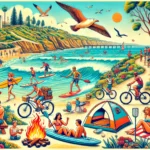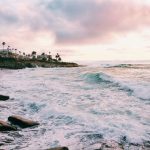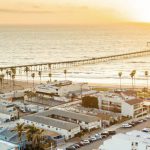Santa Ana Winds & What to Know

Living on the coast of Southern California has many perks–sunshine, warmth, mesmerizing coastlines, great food, and an abundance of outdoor activities. Yet still, San Diego is infamously known for quirky weather patterns that sporadically shake up the community each year, especially those used to primarily warm and sunny days. Whether you’ve lived in San Diego your whole life or are planning to take a trip out to this magical coastal city in the next few months, it’s best to stay informed about potential weather hazards. We dedicated an entire article to enlighten and prepare folks–especially those who thrive in the outdoors–on the Santa Ana Winds, so you know exactly what you’re in for.
Wind conditions are a common topic amongst sports enthusiasts, whose activities are affected by the flow and directional shifts of the wind. You might have heard a surfer or sailor comment on the winds in San Diego, stating that the wind conditions are perfect for the occasion or that it is too blown out to set sail or paddle out. Compared with average and subtle changes in wind patterns, the Santa Ana Winds are an amplified weather obstacle that, for most, can be off-putting. But what exactly are they, and where do they come from?
Table of Contents
What Are Santa Ana Winds?
The Santa Ana winds are wildly strong, intensely hot, and dry downslope winds that originate inland and affect coastal Southern California–namely Los Angeles and San Diego County. These intense downhill flowing winds can reach up to 70 mph in parts of Southern California, which is a major hazard to nature and the surrounding communities. Trees, branches, power lines, and even weak structured buildings are at risk of collapsing–putting people, animals, or habitats in danger. Or worse–the increased wind flow and dry vegetation that results can ignite wildfires, destroying whatever lies in the way. For reference, gale force winds sit at around 43mph, which is extremely powerful. You can only imagine what 70 mph winds look and feel like coming head-on.
Most of these winds start as cold air in a high-pressure area, such as the Great Basin and Upper Mojave Desert. The cold air then channels through the high-pressure system, circulating in a clockwise motion. When confined between mountain ranges and canyons, the air begins to build pressure and compresses, becoming hot and forceful, like rushing water. This compression can create warmer wind by tens of degrees Fahrenheit per mile it travels, which causes the air’s humidity to plummet, relatively. The hot, dry, and strong air dries out vegetation, picks up speed, and aggressively surges into low-pressure areas such as the low-lying coast and then proceeds to move offshore out into the Pacific Ocean.
The wind operates similarly to the force of a very powerful water source. Think of water rushing down the drain at high speed, paralleling the motions of a tornado. When the compressed hot air gets trapped and begins to descend from the high elevation areas, it pours through mountain canyons with enormous force, squeezing out into the surrounding environments with no remorse. Naturally, Santa Ana winds can be very damaging.
Why Santa Ana Winds Are Sometimes Referred to As “Devil Winds”
You may have never encountered the term Santa Ana Winds before, but you’ve probably heard San Diegans mention the “Devil Winds.” The term Santa Ana Winds derives from a Native American term for devil winds due to the scalding hot temperature of the wind. According to legend, Native Americans associated the strong winds with an evil presence–something fiery and destructive. Once the Spanish colonized, missionaries altered the term devil winds to “Caliente Aliento de Satanas”–the hot breath of Satan and since it was shortened and Americanized to Santa Ana Winds.
The Devil winds swoosh down from inland deserts and the Great Basin, pushing smoke and dust from wildfires far out over the Pacific Ocean, and it’s easy to see why one might associate its force with the devil. The destructive nature and element of fire that results from these fierce winds evidently mirror attributes of the devil.
When Do Santa Ana Winds Start?
Typically, the strongest winds blow during the cooler months, beginning early to mid-fall and extending through winter with the potential to continue into early spring. October through January will see the worst of the Santa Ana winds, and on rare occasions, it might peak in March, but they can occur any time after August and before June. The events and chaos during the peak last anywhere from 12-24 hours, though the dramatic weather conditions can persist for a few days. Get ready because we are about to enter Santa Ana winds season!
Santa Ana Winds Superstition
If you’ve experienced the Santa Ana Winds first hand, you’ve probably heard of the Santa Ana Winds superstition. People sometimes blame their out-of-pocket behavior on the wind, stating something like “The Devil Winds Made me do it.” But why is this?
Oddly enough, one outcome of the winds is people emitting higher than average levels of serotonin, which is associated with the nervous system. This triggers specific physical and mental behavior that is abnormal or amplified, including hyperactivity, feeling tenser, more irritable, or downright crazy. It can cause people to act impulsively or have feelings of uncertainty, resulting in reckless or unexplained behavior. That’s not to say you have the right to go buck wild when the winds are upon you, but you have been warned.
Santa Ana Winds’ Effect on Humans
When in the presence of the Santa Ana Winds, Southern California folks can feel physically sick. Why? There’s something in the wind, alright. The Santa Ana Winds encompass an excess of positive ions, which–as mentioned above–can trigger a response in the nervous and immune systems. Wind forces tend to overcharge people with electrical energy, and it can wreak havoc on physical and mental state; your hair might even stand on ends.
Also, when humidity plunges abruptly, our sinuses and respiratory tract don’t know how to handle it. They aren’t designed to combat such drastic shifts, and side effects can include headaches and nausea. The stronger the wind, the more matter it contains, and the more symptoms people report feeling. If you notice heightened allergies or sinus issues, or are feeling lightheaded or nauseous when the winds are picking up, you can rightfully blame the Santa Ana Winds.
Santa Ana Winds in San Diego
San Diego Santa Ana winds can be detected with satellite imaging, so unlike our predecessors who suffered through unprecedented wind conditions, we’ll know what’s coming beforehand. When the winds are approaching, it is recommended to refrain from engaging in activities that might become dangerous due to high winds. It is best to stay indoors and away from unsound structures or trees during this time, because who knows what could happen. It can be dangerous on the water as the waves get super choppy, so swim at your own risk.
That said, the Santa Ana Winds and the aftermath can be great for sailing and surfing, depending on the conditions. For professionals, surfing or sailing the Santa Ana Winds can be pleasurable because offshore winds smooth over the water’s surface. This can quickly become a surfers paradise. At their peak, however, it can make the ocean an alarming place to be.
Now that you’re aware of the chaos that ensues during the Santa Ana Winds in San Diego, you can mentally prepare for the wrath ahead. Remember that the Southern California Santa Ana winds are no joke. You can get seriously injured, so take necessary safety measures and shelter in a safe place if you are uncertain about what to do. For the daredevil surfers and sailors who go against the grain to catch a good wave, take full advantage of the swell, but be safe!
You may also want to check out this article about atmospheric rivers in San Diego for additional insights on our unique weather and climate here in SoCal.
The top photo in this article is courtesy of Wikipedia (photo credit). It features satellite imagery of the Santa Ana winds off the coast of San Diego.





